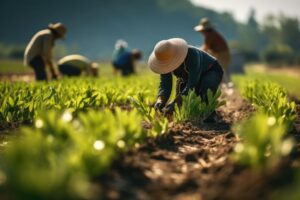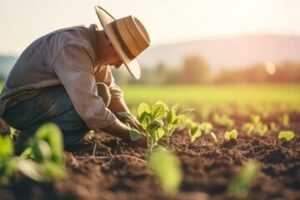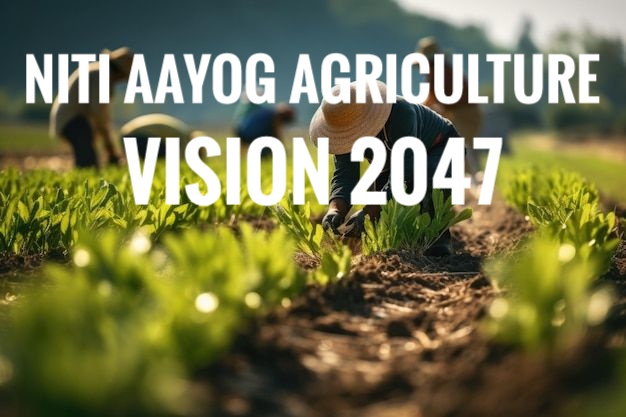🌾 NITI Aayog Agriculture Vision : Self-Reliant, Climate-Smart & Profitable Farming

- Goal: Make Indian agriculture profitable, climate-smart, and self-reliant by 2047.
- Focus: Pulses & oilseeds self-sufficiency, digital markets, post-harvest value.
- How: Precision tech (AI/IoT/drones), water efficiency, FPOs, and market reforms.
What is the Agriculture Vision 2047?
Think of it as a long-term blueprint to transform Indian agriculture into a modern, resilient and farmer-first sector by 2047—our centenary of independence. The vision goes beyond yields to include incomes, markets, climate resilience, and nutrition security.
In simple words: Better seeds + Smart water + Right price + Less risk = Prosperous farmers.

Reference reading: NITI Aayog (Official) • e-NAM
Key Strategies & Pillars
1) Productivity via Science & Tech
- Adopt high-yielding & climate-resilient varieties with strong seed systems.
- Use AI/IoT, remote sensing, drones for precision input and crop health.
- Digital advisory & open ag-data for timely, localized decisions.
2) Diversification for Risk & Nutrition
- Shift from monocropping to pulses, oilseeds, millets, horticulture.
- Region-specific crop planning aligned to water and soil profiles.
3) Post-Harvest & Value Addition
- Warehousing, cold-chain, processing clusters near production zones.
- Quality standards, branding, and export-grade packaging.
Pulses & Oilseeds Self-Sufficiency
Why it matters: India consumes more pulses and edible oils than we produce. The vision targets import reduction through domestic strength.
- Expand area under high-yield pulses & oilseeds; incentivize via MSP & assured procurement.
- Promote short-duration & drought-tolerant varieties for climate variability.
- Localized seed hubs, cluster demonstrations, and farmer training.
- Encourage intercropping (e.g., pulses in cotton/sugarcane belts).

Markets, FPOs & Farmer Incomes
- Stronger price discovery on e-NAM with assaying, grading, and logistics integration.
- Scale FPOs for inputs at wholesale rates and better bargaining power.
- Link to exports where comparative advantage exists.
- Promote contract farming with fair templates and risk-sharing.
Climate, Water & Soil Health
Smart Water Use
- Micro-irrigation, on-farm ponds, and scheduling via weather advisories.
- Shift water-intensive crops to suitable regions with voluntary incentives.
Soil & Carbon
- Soil testing + balanced fertilization + organic amendments.
- Encourage low-till, residue management, and carbon-smart practices.
Actionable Tips for Stakeholders
For Farmers
- Join your nearest FPO for inputs and marketing.
- Adopt at least one precision tool this season (soil sensor, drone service, or app advisory).
- Try one diversification move—pulses or oilseeds intercropping. NITI Aayog Agriculture Vision
- Build services around drone spraying, remote diagnostics, and marketing.
- Offer subscription bundles (advisory + inputs + buy-back).
- Targeted incentives for pulses/oilseeds clusters.
- Invest in storage, cold-chain, and rural logistics.
- Strengthen quality standards and export facilitation.
FAQs
Is this only about yields?
No. It covers income, resilience, markets, and sustainability—a 360° upgrade of the agri system.
Where can I track policy updates?
Follow NITI Aayog at https://www.niti.gov.in/ and your state agriculture department portals.
How do smallholders benefit?
Through FPOs, digital advisories, better storage/processing, and fairer market access on platforms like e-NAM (https://enam.gov.in/web/).
Liked this explainer? Tell me what to cover next.
Drop your questions in the comments—what’s the biggest hurdle you see: climate risk, water, markets, or technology adoption?

